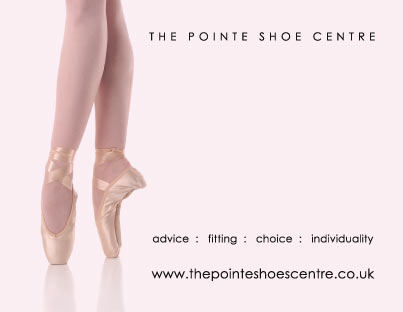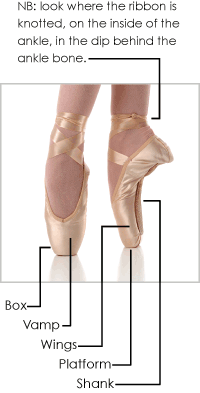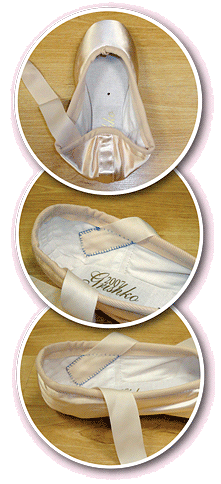advice : fitting : choice : individuality
Pointe Shoe Advice, Tips and FAQS
What makes pointe shoes special?
Pointe shoes are carefully hand crafted using a process that has evolved over more than a hundred years. Natural materials are used to make the shoes, such as corn starch and water, making a glue which is then combined with hessian or card stock that bonds it together and is baked to get the hard box on the end. Pointe shoes are still hand made using traditional methods and the shoes we offer are either made in England, Russia, Thailand or France, depending on the brand.
Pointe shoes are works of art, have a look at the picture on the right for the main features that make up the shoe.
Every dancer has unique feet, with variations that include toe length and shape, arch flexibility, and mechanical strength. Consequently, most pointe shoe manufacturers produce more than one model of shoe, with each model offering a different fit, as well as custom fitted shoes. Regardless of the manufacturer or model, however, all pointe shoes share two important structural features that enable dancers to dance en pointe:
- A box within the front end of the shoe that encases and supports the dancer's foot. A shank, which is a piece of rigid material that serves to stiffen the sole so as to provide support for the arch of the en pointe foot.
- The exterior of a pointe shoe is covered with fabric, thus concealing the box and other internal structural elements and lending an aesthetically pleasing look to the shoe. Most pointe shoes are covered with satin and are most often available in light pink or flesh tones. Dancers Boutique is able to specially order a wide range of coloured pointe shoes, made in a variety of different coloured satins, for you to wear or purchase as a keepsake or a gift for someone special.
A short history on how the pointe shoe came to be
Ladies began to dance ballet in 1681, twenty years after the flamboyant (and prolific ballet dancer himself) King Louis XIV of France ordered the founding of the Académie Royale de Danse. Around that time, ladies ballet shoes had heels. The Mid-18th century dancer Marie Camargo of the Paris Opéra Ballet is credited as being the first to wear a non-heeled shoe, enabling her to perform leaps that would have been difficult, if not impossible, in the more conventional shoes of the age.
As ballet progressed and audiences began to enjoy the image of dancers floating and leaping across the stage, choreographers tried to find a way to make their ballerinas look more ethereal. Marie Taglioni was the first ballerina to dance on her toes throughout a performance of La Sylphide in 1832 and she did this by stuffing the end of her soft satin ballet shoes with wool and adding leather tips to the ends for stability. Can you imagine dancing en pointe in these shoes, purely using your strength to support yourself?
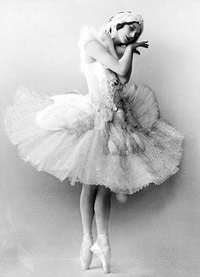
The birth of the modern pointe shoe is often attributed to the early 20th-century Russian ballerina Anna Pavlova (shown here on the right she was born in Saint Petersburg in 1881 and died in 1931). She was one of the most famous and influential dancers of her time. Pavlova inserted toughened leather soles into her shoes for extra support and flattened and hardened the toe area to form a box. This helped her to balance and endure a full performance en pointe.
Pointe shoes have come a long way since the days of Marie Taglioni and Anna Pavlova and modern day pointe shoes are specifically fitted to a dancers feet and individually selected for style, strength and the needs of the dancers. You will probably become very attached to your new shoes and, if you take care of them, they will give you many hours of enjoyment!
Preparing your feet
It is advisable to keep your toenails very short to avoid unnecessary discomfort in your pointe shoes. If you wear convertible ballet tights, carry some plasters or micropore tape with you so you can cover any areas of your feet that are rubbing during class. You may want to harden your skin by wiping surgical spirit on your feet every day.
Preparing your new pointe shoes for use
Securing your shoes with satin ribbons
Ribbon for pointe shoes is wider than regular ballet shoe ribbon and should be sewn very securely into the lining of the shoe to give maximum support and help to 'hug' the shoe into the dancers foot. You will need a slightly longer piece for securing to the inside or instep of each shoe as it has to wrap around the ankle further - if you have purchased your ribbon from us, it will already be cut for you in two correct lengths that just need to be halved to give you a long and short piece for each shoe.
Sewing on the ribbons
- Fold the back of your shoe flat onto the sole (this marks the place where you would normally put your elastic)
- Slot the ribbon into the fold so that it is angled forwards and up the side of the shoe, from the sole to the drawstring
- Sew the ribbon on to the shoe lining, avoiding stitching over the drawstring. Use the long piece for the inner side and the short piece for the outer side of the shoe. You will note on the diagram to the right that we have used blue thread to highlight where to sew the ribbon on to the shoe. We have available the correct light pink thread along with easy threading sewing needles for you to use.
Protecting the platform
Traditionally, dancers darned the ends of their shoes to protect the satin from tearing. This is still an option but many ballerinas prefer the newer 'stick on' suede leather caps (see below)that are quick, easy and just as effective.
Darning
If you decide to darn your shoes, use pink darning thread and a darning needle. Starting in the middle of the platform, use chain stitch and spiral outwards in a circle. Make sure there aren't any gaps and that it covers the end and slightly down the sides and back, keeping the stitches smooth and as flat as possible.
Suede leather caps
These can just be glued onto your shoes, using a strong fabric glue such as the non-toxic and solvent free Copydex natural latex rubber based adhesive or for a really strong bond, a sfast-drying solvent based instant contact adhesive like Evo-Stik Impact, both of which we sell in store for far less than the big DIY stores! Avoid using superglue as it can dry and crack. The cap will cover the platform and round underneath the shoe to sit flush with the sole. You will most likely need to trim the suede so it doesn't overlap the sole.
We also provide a suede leather cap sticking service if you are nervous about getting glue on your new pointe shoes! In addition, we sell a wide selection of pointe shoe accessories such as shoe bags, ribbons, toes cap, padding, animal wool, darning thread and sewing needles at Dancers Boutique.
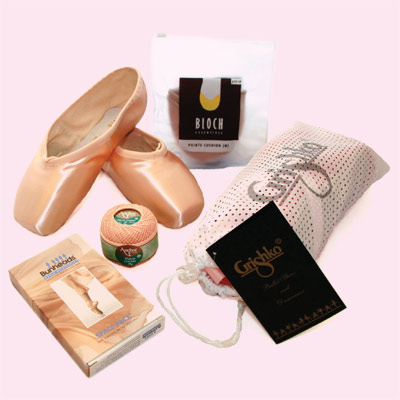
Some great tips on getting the best from your new pointe shoes
Tip!
To break in your shoes for class, sleep in them! The warmth of your feet will soften the glue and they will start to mould to your foot shape.
Tip!
Take your shoes out of your bag after class. If you hang them up somewhere to allow them to dry naturally and thoroughly and they will last longer as well as maintaining the shape of your foot!
Tip!
Massage your feet after pointe class to relax and stretch the muscles.
Tip!
Want to work the demi pointe of the shoe? Do some gentle pony trots wearing your shoes at home. It takes patience but it works!
Tip!
Grishko pointe shoes have been designed with a special roll through feature to enable easier roll up onto pointe - they will therefore need less breaking in.
Tip!
Do you need to clean the satin on your shoes? You could try nail varnish remover, it should clean dirt and dust off the surface - a trick used by professional ballerinas.
Don't forget, if you have any other questions about your shoes, please phone us and we will be pleased to help!
Breaking in your pointe shoes
As you have felt, your new shoes are very hard! They will soften and mould to your feet with wear but you may wish to work on them a little before your first class.
Once the ribbons are sewn on, wear your shoes around the house, sleep in them and sit and watch TV in them. The warmth from your feet and the natural movement will start to break them in and make them more comfortable and flexible. It's best to wear socks over them to protect them and avoid going up and down stairs as this can place too much pressure on the shank.
If you feel you would like to gently bend and manipulate the sole of the shoe, make sure you are doing it in the right place! Your shoe needs to be flexible at demi pointe and at the heel - i.e. NOT in the centre of the sole as this is where you need the full support of the shank to protect you whilst you are on pointe.
Heel
To find the exact place to break the shoe in, put the shoe on, stand your foot on pointe and mark where your foot ends and your heel begins. This is where you should gently bend the shoe (just holding it between your thumb and fingers and working backwards and forwards). When this part of the shoe has softened, it will allow the shoe to sit into your arch more easily, giving you a beautiful look on pointe without affecting the security and safety of the shoe.
Demi pointe
You will know where you need the shoe to be flexible to achieve full demi pointe - probably about a third along the sole from the front of the shoe. Again, gently work the shoe between your fingers, to encourage flexibility and making it easier to roll up onto pointe.
TAKE CARE! Whilst it is good to try and soften the shoes it is very easy to be too heavy handed and snap them. We definately do not recommend harsh hammering, bashing or shutting in doors!
Frequently asked questions
How can I stop my ribbon from fraying?
Cut the ribbon on an angle and either dab clear nail varnish on the ends, spray hairspray on the ends or carefully burn the ends - yes this does work!
I am wearing toe pads but my little toes are still sore, what else can I do?
Try using extra padding for individual toes. Bunheads have a great selection of jelly toes and tubes that can be cut to size, worn over any toes and should fit in with your pads. Bring your shoes to Dancers Boutique and ask our advice on the best accessories for you.
How long will my pointe shoes last?
This depends very much on how often you wear them, the strength of your foot and the way in which you work in your shoes. Younger dancers may well grow out of their shoes before they wear out and some professionals who are training and performing every day need a new pair every week!
How will I know when I need new pointe shoes?
The purpose of your pointe shoes is to protect your feet. Once the shoes have become too soft, they will no longer support your feet adequately and you will need new ones. If you feel your foot is going too far over on pointe or that the box is no longer hard, ask your teacher to check them or bring them into the shop for us to have a look at.
Will I need the exact same pair again next time?
Probably not! You will notice that your foot changes shape once you have started training on pointe and it is likely that you will need a different width fitting for your second pair. As your feet get stronger and if you increase your training, you may also need a different make of shoe that offers more support, so it is worth having a full fitting for your first few pairs of pointe shoes. Subsequent fittings won't take as long, as you will have a clearer idea of what you want and we will assess how you have worn your old shoes to give us an indication of which style you will need next.
